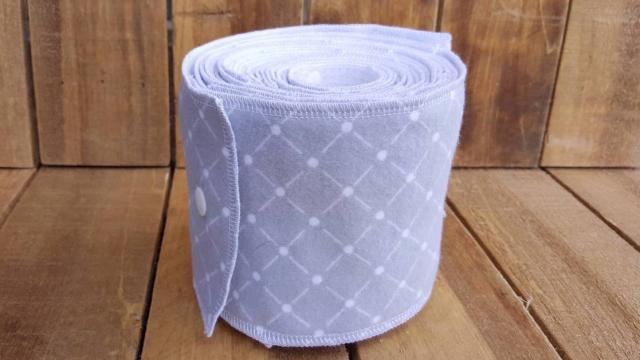This story was written well before the pandemic — but now here we are, hoarding toilet paper and fearing the next shortage, and Nick Douglas’ message feels even more timely, even urgent. So we present this to you as a reminder that cloth toilet paper should never be something to consider. Everything’s bad, but it’s not that bad. — Eds.
“The family cloth” is a reusable alternative to toilet paper, made of rags, old t-shirts, sewn fabric, or purchased cloth wipes. They are mostly used for wiping pee, but some families use them for poop and periods. The practice (common until the modern era) is now mostly featured in eco-conscious and “frugal” housekeeping blogs and Etsy shops. A while back BuzzFeed published a sympathetic explainer about the wipes. (At the end, readers are asked to respond with “Good for them, not for me!” or “I’d try it at some point.”) Before it grows any more, let’s make it clear: “Family cloth” is not a life hack.
The downsides of cloth wipes (we refuse to call them “the family cloth”) are obvious: You have to keep a sealed hamper, and you have to do more laundry. Cloth users argue that it’s really not a big deal, that it’s no worse than dealing with dirty underwear, as if dealing with dirty underwear isn’t already bad. They insist that the practice is hygienic, that the wipes don’t smell much, that it’s all not a big deal really. OK.
Cloth wipes also pose a problem for guests, in that you should never offer cloth wipes to your guests. “We always keep a box of facial tissues in the bathroom cabinet for guests,” says one of BuzzFeed’s sources. This is gross and pointless! Keep a roll of toilet paper for your guests! Good lord!
There are two arguments in support of cloth toilet wipes: that they save the environment, and that they save money. Let’s analyse the implicit premises: that toilet paper is expensive, and bad for the environment.
Toilet paper is expensive
Toilet paper costs…not that much? If an adult uses about 50-100 rolls a year, that’s well under $140, even for high-end Cottonelle. A hundred bucks a year is worth a small scrimp, not the significant life change of storing, washing, drying, and folding rags covered in poop and pee and menstrual fluid.
Toilet paper hurts the environment
Each year, American toilet paper consumes anywhere from 7.5 to 54 million trees (some of it old-growth), 17.3 terawatts of electricity, and 474 billion gallons of water (about 49 l per roll). And as toilet paper catches on in developing countries, the environmental cost is rising. In the U.S., product review site The Wirecutter recommends Cottonelle and Charmin over recycled brands, but the best they can say for their environmental impact is this:
Both Kimberly-Clark, maker of Cottonelle, and Procter & Gamble, maker of Charmin, pledge that their wood sources are 100 per cent legal and that they buy only from vendors practicing sustainable forest management.
Ah, at least it’s legal.
Washing cloth wipes uses up water and electricity too, but to be fair, it’s probably less than toilet paper’s 49 l per roll. The specific amount depends on whether you use hot water, whether you hang your wipes to air dry, and whether you throw the wipes in with your other laundry.
But that’s irrelevant, because there are two technologies that cut down on waste and skip the washing machine entirely: recycled toilet paper, and bidets.
Recycled toilet paper saves trees
I’ve personally been reluctant to switch from cushy Cottonelle ever since a bad experience with Seventh Generation. But the Natural Resources Defence Council lists 17 brands of recycled paper; surely one of those is soft enough to wipe with. And several of these brands are cheaper than top-of-the-line non-recycled brands like Cottonelle and Charmin.
Bidets save even more trees
Bidet attachments (which fit right onto your toilet) can clean you up with little or no need for toilet paper. They’re much more expensive; the Wirecutter’s top pick runs $600, and their budget pick is $330. But if you can keep yours running for five years (major manufacturers offer repair service), you’ll come out on top. Or go dirt cheap: One $45 model on Amazon has a 4.5 star rating after almost 5,000 reviews.
Bidets are environmentally friendly; just two cups of water replaces your wiping. They’re perfectly hygienic and they’re popular in Europe, Asia, and South America. Americans sometimes run into them in high-end Japanese restaurants; unlike cloth wipes, bidets work well in public settings.
So why ignore these obvious solutions in favour of wiping your butt with cloth? In the words of Rosé Princess, who expertly roasted a terrible, since-deleted video of crafty “hacks” like building an ottoman out of 36 soda bottles:
White people want to be poor so bad.
— Anastasia Beaverhausen (@ParisianRebel) January 3, 2018
More broadly, some people are maybe play-acting frugality and eco-consciousness, rather than assessing what steps will do the most good. They’re building themselves a lifestyle that feels virtuous, independent of whether it is virtuous. They’re buying specially sewn wipes that snap together like a child’s snowsuit.
This is annoying, time-wasting, and pretentious, but is it harmful? It’s certainly not great PR for environmentalism; part of humanity’s problem is we view frugality and eco-consciousness as weirdo hippie bullshit. And in the case of cloth butt wipes, we’re right.
This story was originally published in 2018 and updated on 7/24/20 by Alice Bradley. Updates include: reformatting subheds, updating links and prices to bidets, and added introduction.

Leave a Reply
You must be logged in to post a comment.